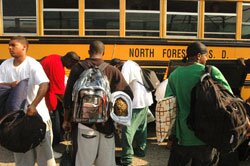 |
 |
 |
|
|
||||||||||||
|
|
||||||||||||
| Email Article | Printable Page |
First Katrina, Then Rita
 |
|
Photo credit: Earlie Hudnall/Texas Southern University
Texas Southern U. students prepare to board the bus to Texas A&M University on Sept. 22.
|
Texas Southern University weathered the effects of Hurricane Rita with minimal damage and a safe and orderly evacuation of more than 10,000 students, according to university officials.
On the main campus in Houston, broken windows on the university�s unfinished science building and a few downed trees were the extent of Rita�s wrath.
The university initially canceled classes Thursday and Friday, Sept. 22 and 23, but closed also on the following Monday and Tuesday to allow students who evacuated enough time to return. Classes were to resume Sept. 28.
�I was just like, �not again�,� said Cassandra Davis, who is continuing her junior year at Texas Southern after being evacuated from Xavier University of Louisiana in New Orleans as a result of Hurricane Katrina. �I felt like all I was doing this semester was running from hurricanes."
She was forced to run first from Katrina, then Rita.
Even though Davis was worried, the Houston native and pre-med/biology major did not leave the area. She moved from her off-campus apartment near Texas Southern to her parents� house in Missouri City, about 20 miles southwest of Houston. Because the house was not in a mandatory evacuation area, Davis� parents chose to stay home.
�Luckily, the hurricane decided to turn the other way . . . it barely even rained here," Davis said. "Plus, when I saw the situation on the highway on the news -- people passing out, running out of gas -- I decided that maybe it was the best thing for me to just stay home."
Despite projections that Rita would head straight for Galveston and Houston, the Category 3 storm changed directions. Some of the most extensive damage in Texas occurred in the cities of Beaumont and Port Arthur. Lake Charles and Cameron, La., also felt the effects of Rita�s 117-mph winds and heavy rains.
For students who had no transportation and nowhere to go, the university arranged shelter.
�The evacuation was absolutely necessary,� said Winifred King, Texas Southern's director of communications. �All indications were that this was probably the most dangerous storm to head this way in years. While meteorology is not an exact science, it was exact enough that we needed to get out of" here.
Taking no chances after the unexpected destruction caused by Hurricane Katrina in Louisiana, Texas Southern first closed its campus, then evacuated all of its student housing: Lanier East and West dormitories, and University Courtyard, Tierwester Oaks, Richfield Manor and Greystone Apartments privatized housing.
�Our main concern was how to handle students who were from out of town or out of the country with no transportation to get to a place of absolute safety,� said King.
Texas Southern provided transportation for more than 100 students to Reed Arena at Texas A&M University in College Station. The university selected the location with help from the governor�s office in Austin, after hotels as far north as Arkansas said they could not accommodate the number of students evacuated.
Texas Southern President "Priscilla Slade was adamant that all the students stay in one hotel,� King said. �We were able to get accommodations for the students as well as chaperons �- campus housing employees �- and even a couple of police officers that accompanied them for safety.�
The problems that plagued Houston�s evacuation process overall �- traffic stalled for miles at a time, limited access to gasoline, the sweltering heat � did affect the journey from Houston to College Station.
The normally two-hour trip took 15 hours, according to evacuee Tenya Moses, a sociology major. But she chose to look on the bright side.
�The whole thing was quite an experience,� said Moses, 24, a sophomore and a resident of the university's Greystone Apartments. �But it was a chance to mingle and meet students that I ordinarily would never have contact with.�
Six school buses took the students to College Station, where they slept on cots in suites at the Reed Arena and were fed in the university�s cafeteria. The students never lacked for entertainment. They had access to Texas A&M�s recreation center and some even attended a few parties.
After three nights in the arena, the students left Texas A&M Sunday morning, Sept. 25, to return to Houston.
Some, like Texas Southern geology major Joe Hopkins, came back with a newfound respect for those displaced by Katrina �- and the 800-plus students among them who enrolled at Texas Southern.
Hopkins traveled to College Station with Texas Southern's football team after a game was canceled in Louisiana. The Florida native said he felt he would be safe with his coaches and teammates.
�It was hard going down there -� the longest that I have ever been on a bus,� said Hopkins. With the traffic, the normally two-hour trip took 10 hours. �I wasn�t scared; I was just hoping that everything would be all right. But it was hard that first night . . . I felt what the people from New Orleans must have been feeling in the Reliant," or Astrodome.
Posted Sept. 27, 2005
In News
Slain Student's Mom Condemns "Don't-Care Attitudes"
College Administrators Tighten Security, Try Background Checks
Students from 3 Schools Picket Nashville Store
| Home | News | Sports | Culture | Voices | Images | Projects | About Us Copyright © 2005 Black College Wire. Black College Wire is a project of the Black College Communication Association and has partnerships with The National Association of Black Journalists and the Robert C. Maynard Institute for Journalism Education. |